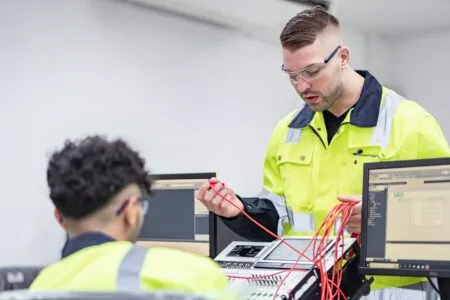What is Dirty Electricity?
Dirty electricity refers to a form of electrical pollution that occurs when the normal alternating current (AC) electrical flow is interrupted or distorted, resulting in an erratic flow of energy through the wiring. This phenomenon is often caused by modern electronic devices and energy-efficient appliances that require power at different voltages or frequencies than those provided by the standard electrical system. When these devices convert AC to direct current (DC) or alter the AC voltage to suit their needs, they can introduce higher frequency electrical noise or transients back into the power lines.
These electrical irregularities, also known as electromagnetic interference (EMI) or high-frequency voltage transients, can interfere with the smooth sinusoidal wave of the electrical current. Common sources of dirty electricity include:
- Dimmer switches
- Fluorescent lighting
- Uninterrupted power supplies (UPS)
- Computers and printers
- Variable speed motors and fans
- Solar panel inverters
- Energy-efficient devices and LED lighting that use switching power supplies
Health Risks Associated with Dirty Electricity
Preliminary research suggests that exposure to dirty electricity may lead to a range of health symptoms, such as fatigue, headaches, difficulty concentrating and other neurologic symptoms. Workers particularly sensitive to electromagnetic fields (EMF) might experience more pronounced symptoms. Although conclusive evidence is still forthcoming, the precautionary principle advises taking reasonable measures to reduce exposure in the workplace.
Understanding the Sources of Dirty Electricity
To effectively mitigate the risks associated with dirty electricity, it’s essential to first identify its common sources in a workplace. These can include:
- Office equipment such as printers, copiers, and computers that use switching power supplies.
- Energy-efficient lighting solutions like compact fluorescent lamps (CFLs) and LED lighting.
- HVAC systems with variable frequency drives.
- Power-saving devices and uninterruptible power supplies (UPS).
- Wireless technology and chargers that create high-frequency energy.
Identifying these sources helps in understanding where dirty electricity might be generated and where mitigation efforts should be concentrated.

Strategies for Protecting Workers
1. Assessment and Monitoring The first step in protecting workers is to assess the level of dirty electricity present in the workplace. This can be done using specialized meters designed to measure high-frequency transients and electromagnetic pollution. Regular monitoring can help identify problem areas and track the effectiveness of interventions.
2. Implementing Dirty Electricity Filters One of the most direct methods to reduce dirty electricity is through the installation of EMF filters. These devices plug into electrical outlets or connect directly to the building’s wiring to filter out high-frequency electrical noise. Filters should be strategically placed where dirty electricity sources are identified, and regular maintenance should ensure they continue to operate effectively.
3. Upgrading or Modifying Equipment
- Choose Clean Technology: When purchasing new electronic equipment, opt for models that are designed to minimize electromagnetic emissions. Some power supplies in electronic devices are designed with better filtering systems that produce less EMI.
- Retrofit Existing Equipment: For existing equipment, consider retrofitting with additional internal or external EMF filters or replacing older devices with more energy-efficient and less polluting models.
4. Optimizing Electrical Wiring and Infrastructure Faulty or outdated wiring can exacerbate problems related to dirty electricity. Ensure that electrical infrastructure is properly installed, grounded, and maintained. In areas with significant equipment emitting dirty electricity, dedicated circuits can help isolate electrical noise.
5. Spatial Design and Layout Adjustments Arranging workplace layout can also help minimize exposure. For instance, sensitive equipment and frequently occupied workspaces should be located away from known sources of EMI. Additionally, creating buffer zones around high-emission devices can reduce workers’ direct exposure.
6. Developing Workplace Policies and Awareness Educating employees about the potential risks of dirty electricity and the steps the company is taking to mitigate these can be beneficial. Training staff to recognize symptoms of EMF sensitivity and encouraging reporting of such symptoms can help in early detection and intervention. Establish policies and run online induction for the use and maintenance of devices that contribute to dirty electricity to ensure they are used safely and efficiently.
7. Regular Review and Policy Update Workplace safety is a dynamic field, especially as new technologies and research findings emerge. Regularly review and update policies related to dirty electricity, staying informed about the latest research, technologies, and mitigation techniques.
8. Professional Consultation For workplaces with complex systems or significant concerns about dirty electricity, consulting with an EMF specialist or an industrial hygienist can provide tailored solutions and additional insights.
Last Words
While the science behind dirty electricity and its health impacts is still developing, taking steps to mitigate its presence in the workplace is part of ensuring a safe and healthy working environment. By assessing risks, implementing protective measures and fostering an environment of awareness and adaptability, employers can stay ahead of the curve and safeguard their employees against the potential risks of dirty electricity, thus promoting both health and productivity in the workplace.



